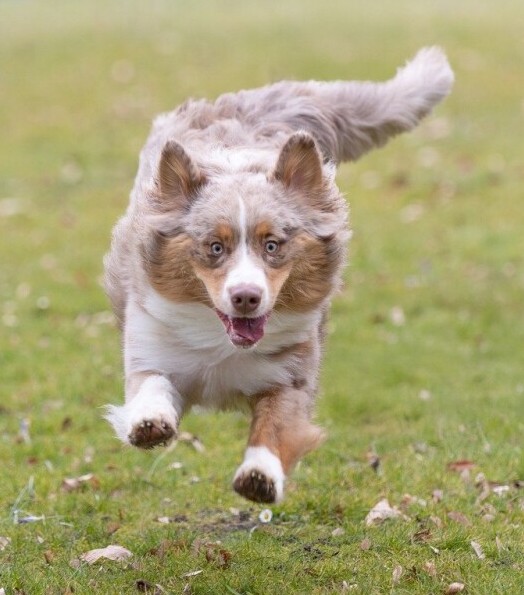
A few of the links in this post are affiliate links. If you buy something, we may earn a small commission (no extra bones from your wallet 🐾). Thanks for helping support the site and all of the dog adventures!
Ever watched your dog race around your backyard like it’s on an invisible racetrack and wonder what’s going on? Those lightning-fast dashes have a quirky name to match—’zoomies’, or in scientific circles, Frenetic Random Activity Periods (FRAPs).
Zoomies are those wild bursts of energy that might look chaotic, but rest assured, they’re a normal part of being a dog. We’re here to help you understand why dogs get this urge, and how best to handle the situation.
Zoomies come with a bunch of tell-tale signs that are hard to miss. Think wide eyes, playful barks, and a whole lot of zigzagging. It’s like your pup’s saying, ‘Catch me if you can!’ It doesn’t matter if you’ve got a tiny Chihuahua or a big ol’ Great Dane—most dogs get the zoomies at some point. The zoomies don’t escape any type of dog.
Interestingly, some dogs are more prone to zoomies than others. Puppies, with their bottomless energy reserves, are frequent frappers. But don’t let an older dog fool you; they get them too, just usually less often. Certain breeds, especially the more energetic ones like Border Collies or Jack Russells, are also known to go off on these hilarious romps.
Nothing to worry about here. Zoomies are just a part of a dog’s repertoire of fun and self-expression, like when they get the occasional urge to roll in the mud or chew through half a dozen socks. It’s all part of the joy of living with a furry whirlwind.
Zoomies are often a result of pent-up energy. Indoor exercise routines can help manage it, as explained in How to Exercise Your Dog Indoors on Rainy Days.

The Psychology Behind Zoomies: Why Do Dogs Get Them?
Ever noticed your dog going bonkers with excitement right after a bath or when you’re about to give them a treat? That’s the magic of zoomies at play, my friend. But why exactly do these energy bursts happen? Dive into the psychology behind this quirky behavior.
The zoomies are often your dog’s way of blowing off some steam. Just like humans feel the need to jump up and shout after sitting through a long meeting, dogs need a release from pent-up energy. If your pup hasn’t had enough playtime, expect those zoomie sessions to be longer and more intense.
Emotions are the big players in this zoomie game. A dog overflowing with happiness might express that through a high-speed dash around the living room. Joy and excitement often trigger these episodes, turning your furry friend into a fuzzy missile zooming around. Sometimes your dog just needs to expend some of that excited energy, and what quicker way to do that than a quick burst?
Then there are the environmental factors. Dogs who get regular chances to explore and play generally have more controlled zoomie episodes than those stuck inside all day. Toss in some new scents or a visit from their canine buddy, and you’ve got yourself a potential zoomie-triggering situation.
Understanding this behavior is all about recognizing your dog’s needs. Once you know the ‘why’ behind the zoomies, you’ll be better equipped to help your buddy manage them. This makes for a happier, healthier, and definitely more fun time together!
Providing engaging toys can channel excess energy into play instead of chaotic zoomies. Explore options in The Best Interactive Dog Toys to Keep Your Dog Busy.

Safety First: Managing Dog Zoomies at Home and Outdoors
Zoomies are all fun and games until someone bumps into a coffee table! These bursts of energy can cause little disasters if your space isn’t prepared. Making sure your pup’s zoomies happen in a safe environment is key to keeping both your pup and your valuables intact. It’s important that your dog has the space so that it can move about freely without being inhibited.
Start with creating a safe zone indoors. Too much clutter might turn a playful sprint into a hazardous adventure. Clear the path by moving any breakables out of reach. If you’ve got slippery floors, think about adding some rugs for traction—after all, nobody wants a doggy version of a slippy-slide in the living room.
When letting your dog loose in the great outdoors, finding a safe space is crucial. Off-leash parks or your own fenced backyard are perfect zoomie spots. Keep an eye out for hazards like sharp objects or gaps in fencing, and make sure your dog can’t dash out into traffic. Make sure that your dog can expend its energy in a space that they won’t get themselves into any danger.
Want an extra layer of safety? Work on a solid recall command. Teaching your dog to come or stop on command can save the day if things get too wild. It’s peace of mind knowing that you can call back your speeding pup if they’re heading towards something dangerous. Practice this and make sure your dog understands that when you tell it to come it will come under any circumstance.
The joy of zoomies is best enjoyed safely, so setting those boundaries turns a crazy run into just another fun part of the day. With a bit of planning, you can let your dog rip around without a worry in the world. Okay, so your dog got a case of the zoomies, now what are you supposed to do about it?
Understanding why dogs exhibit zoomies helps prevent other behavior issues. Learn solutions in Common Dog Behavior Problems and How to Fix Them.

Interaction Strategies: What Should You Do During a Zoomie Episode?
When the zoomies hit, it’s often a joy to watch, but jumping in and engaging with your energized canine can make things even more fun. Channeling that whirlwind energy into playtime can turn a crazy run into a perfect bonding opportunity. Add in a toy or treat and it can become a game that both of you will enjoy.
Try introducing toys that encourage active play. A good tug-of-war rope or a squeaky toy can focus their energy and make their zoomie session productive. Not only does it keep them entertained, but it helps burn off any excess energy without the risk of them knocking over Aunt Sheila’s antique vase.
During a zoomie episode, participating in activities like fetch can also help direct their energy positively. It gives your pup a structured outlet to expend energy and helps reinforce training commands like ‘bring it back’. This way you can expend their energy in a positive and productive way. Beats digging in your yard and chewing up the furniture, right?
Every once in a while, you might need to step in if your dog’s getting too rowdy. Knowing how to calm your pup in the middle of the frenzy is important, especially if things get too intense or if they’re zooming in an unsafe area. A gentle call or distraction with treats might do the trick.
But remember, usually it’s best to let zoomies run their course. Dogs have a natural way of sensing when they’ve had enough, so most will settle down on their own once that rush dissipates. Ensuring they’ve had enough physical and mental stimulation throughout the day can help make those zoomie episodes manageable and safe. And if they do get the urge to zoom, you know that they have the space to do it without breaking anything.
Zoomies can escalate if dogs become overstimulated. Calm them with strategies in How to Calm an Overexcited Dog.
